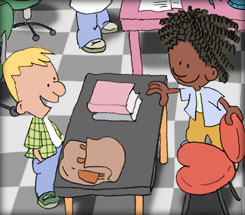Chair and Chair Alike
- August 19, 2013
- By Michael Kline
 Day after day after day, your students come plodding in, drop their gear in the requisite areas, then plop into their seats. The same seats, in the same place, in the same room… zzzzzzzzzz. Huh? Oh, sorry, I dropped off there for a second. And it’s not you, it’s me. I just felt like a nap.
Day after day after day, your students come plodding in, drop their gear in the requisite areas, then plop into their seats. The same seats, in the same place, in the same room… zzzzzzzzzz. Huh? Oh, sorry, I dropped off there for a second. And it’s not you, it’s me. I just felt like a nap.
Owing to the fact that–as a child–you were likely one of those pupils that were even arranged alphabetically within the confines of your homeroom. I know that I was. But it doesn’t have to be that way. You will be pleasantly surprised to find out what a difference it will make if you simply move the furniture around a bit, giving your charges a new perspective within an old environment. There are many ways to organize the seating in your classroom, but here are a few tried and true options to get you started:
Group Seating
Take 4 or 5 desks and place them head to head, forming groups or teams of students, and angle those groups within the room (avoid the horizontal and vertical grid as it will make it difficult for some students to see you). This setup promotes collaborative learning and sharing, and can save a lot of floor space. It can however be challenging for a larger number of students, and can provide distractions for certain students. If you do explore this option, leave a couple of desks to the side as some kids simply don’t work well in groups.
The Horseshoe
You can also arrange the desks in a horseshoe (commonly referred to as a U shape) with you in the center of all the action. This scenario makes very good use of your space and allows you the opportunity to separate friends from friends (you know, the ones who would rather be doing anything else). In addition, it lets you view work as it’s going on and you can see all the faces. If you run out of room, try putting a group of 3 or 4 of your more trusted students in a group in the middle of the U, being sure to leave walking space between them. Be sure to leave a space or two between the longer runs of desks as well, in case you feel compelled to run screaming from the room (I understand…).
Stadium Seating
You can also set up your desks in curved rows with the corners touching, similar to the fashion of seating that you might see in a small stadium. This method allows for you to see what every student is doing, makes it easy for cooperative learning situations, and gives each student a very clear view of the front of the room. It also gives you some extra space for a media cart or projector. And though it is thought to resemble the Roman Coliseum, do not feel as though you are about to be fed to the lions (metaphorically, maybe… but not in reality).
Chaos Theory
You can also have your students arrange their desks willy-nilly, or in a formation that I refer to as chaos. Let the students position seating as they deem fit, with only two caveats: No straight lines, and you must be able to see their faces. Adopting this kind of arrangement will empower and engage your students, and perhaps give you some insight into how they see their environment. Ask them why they chose what they did, and what they might do to make their learning situation even better. It would also serve you well to remind your students ahead of time that this kind of seating arrangement can change faster than the weather in Kansas, so be prepared.
Above all else, seek input from your classroom inhabitants and let them do all of the physical labor. It might even be a good activity for a rainy day…! And remember, sometimes making the smallest change can make the biggest difference.
BTW, when was the last time you moved your couch at home?
Teach. Learn. Enjoy!